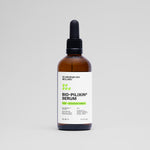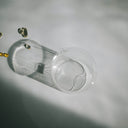Hairline surgery is a cosmetic procedure that helps adjust the position of the hairline, creating a more balanced and proportionate appearance.
Whether you’re dealing with a naturally high hairline, a large forehead, or hair loss, this surgery can be a game-changer for improving facial symmetry and boosting confidence.
Table of content
What is hairline surgery?
Hairline surgery is a cosmetic procedure that moves the hairline lower on the forehead, making it look more balanced and harmonious with other facial features. This can involve removing a small strip of skin or relocating hair follicles for a natural and fuller appearance.
For those who feel self-conscious about their high hairline or large forehead, this procedure offers a way to enhance facial proportions.
Hairline surgery is often chosen by people who want permanent results to improve symmetry or address aesthetic concerns caused by aging, genetics, or past procedures.
It can also be combined with other treatments like hair transplants to achieve even better outcomes.
As your leading source for hair health information over the past 4 years, we never compromise on accuracy. When it comes to your health, you deserve information you can truly rely on - and earning your trust is our top priority.
Here's how Scandinavian Biolabs ensures every piece of content meets the highest standards of accuracy and integrity:
- Credentialed Experts: Our reviewers are actively practicing doctors and medical researchers
- Stringent Reviews: Content undergoes rigorous editing by subject specialists and review by a practicing doctor.
- Evidence-Based: We rely on well-established research from trusted scientific sources like peer-reviewed journals and health authorities.
- Full Transparency: Our editorial standards, writer credentials, reviewer credentials, correction process, and funding are all publicly documented.
- Independent Voice: While we do promote products, we operate in a vacuum to business operations. Our main goal is just an unwavering commitment to providing medically-sound guidance.
You can count on Scandinavian Biolabs to consistently deliver the trustworthy health information you deserve. Read our Editorial Standards.
Types of hairline surgery
There are two main approaches to hairline surgery, each tailored to specific goals and needs.
Forehead reduction surgery
This method involves removing a strip of skin from the upper forehead, near the hairline.
- The surgeon carefully separates the skin and pulls it down to reduce the height of the forehead.
- Excess skin is removed, and the incision is closed with sutures, strategically placed to minimize scarring.
- This technique is best for those with good scalp elasticity and no active hair loss.
Hair transplant surgery
Hair follicles are harvested from the back or sides of the scalp and transplanted to the hairline area.
- This method reshapes the hairline, filling in areas with sparse or missing hair.
- It’s often chosen by people with thinning hair or specific bald patches.
- The results take several months to fully appear as the transplanted hair grows naturally.
Combining forehead reduction and hair transplants
For those with both a high forehead and hair thinning, combining these two procedures can provide optimal results. This approach lowers the hairline while ensuring it looks full and natural.
Who is an ideal candidate for hairline surgery?

Hairline surgery is ideal for people with a naturally high hairline, a large forehead, or hairline concerns caused by genetics or aging. Good candidates typically have realistic expectations and sufficient scalp elasticity to achieve desired results.
You might be a good candidate if:
- Your forehead feels disproportionately large compared to your facial features.
- You have no active hair loss or a family history of severe pattern baldness.
- Your scalp is flexible enough to allow for adjustments.
- You are in good general health and free from conditions that may complicate healing.
Who should avoid this surgery?
While hairline surgery can be transformative, it’s not suitable for everyone.
It may not be the best choice if you:
- Have progressive hair loss or scalp conditions.
- Lack sufficient scalp elasticity for the procedure.
- Have unrealistic expectations about the results.
- Are prone to keloid scars or other healing complications.
Hairline surgery procedure: What to expect
Hairline surgery involves several stages, from preparation to recovery, each playing a vital role in the final outcome.
Before surgery
Preparation is key to a smooth procedure and recovery.
- Consultation: Your surgeon will evaluate your hairline, scalp elasticity, and goals.
- Personalized plan: They’ll create a surgical plan tailored to your needs.
- Pre-surgery tips: You may need to stop certain medications and avoid alcohol or smoking.
During surgery
The procedure itself depends on the chosen method.
For forehead reduction, the surgeon begins by marking the new hairline and making a precise incision along the marked area.
The skin is then carefully adjusted, and any excess skin is removed. Finally, sutures are placed strategically to close the incision and minimize visible scarring.
For hair transplants, hair follicles are harvested from the back or sides of the scalp and implanted into the desired hairline area.
Tiny incisions are made to create a natural-looking result. Most procedures are performed under local anesthesia, and the entire process typically takes a few hours.
After surgery
Recovery requires patience but is manageable with proper care.
- What to expect immediately: Swelling and bruising are common, especially around the forehead, eyes, and eyelids. The scalp may feel tight, and some discomfort is expected in the first few days.
- At-home care: It’s important to keep the incision area clean and dry. Your surgeon may prescribe medications to help manage pain and prevent infection. Strenuous activities should be avoided for at least two weeks to support proper healing.
- Timeline for results: Most of the swelling improves within three to four weeks. While the hairline position looks noticeably improved early on, final results can take six to twelve months as the area fully heals and the hair grows naturally.
Dos and don’ts after surgery

Taking care of your scalp after hairline surgery is key to a smooth recovery and great results. Following these dos and don’ts can help you heal faster and avoid complications.
Dos:
- Follow your surgeon’s instructions carefully, including how to clean and care for the incision area.
- Keep your head elevated, especially while sleeping, to reduce swelling.
- Use any prescribed medications, including pain relievers and antibiotics, as directed.
- Be gentle when washing your hair—wait until your surgeon gives you the green light.
- Stay hydrated and eat a healthy diet to support healing.
It’s just as important to know what not to do to avoid setbacks during recovery.
Don’ts:
- Avoid touching, scratching, or picking at the incision area, even if it feels itchy.
- Skip intense workouts, bending over, or heavy lifting for at least two weeks.
- Stay away from saunas, hot tubs, and direct sunlight until your surgeon says it’s safe.
- Don’t apply hair products like gels, sprays, or dyes near the incision area until you’re fully healed.
- Resist the urge to smoke or drink alcohol, as these can slow healing and increase the risk of complications.
When to expect final results after the hairline surgery
Most people notice an immediate improvement in their hairline after surgery, but the final results take time. Swelling and mild bruising are common in the first few weeks, and it can take six to twelve months for the area to fully heal and for hair growth to look completely natural.
In the early stages, you might experience some temporary hair shedding, especially around the incision line. This is completely normal and part of the healing process.
Over time, the transplanted or adjusted hairline settles into its final shape, and any scars begin to fade.
By the six-month mark, most of the swelling is gone, and hair growth becomes more noticeable. However, full results—including hair density and a natural appearance—typically develop after a year.
Patience is key, and sticking to your surgeon’s aftercare advice helps the process go as smoothly as possible.
Tips for maintaining the results after hairline surgery
Once your hairline has healed, a little care can go a long way in keeping the results looking great for years to come.
Here are some tips for maintaining the results after hairline surgery:
- Keep your scalp clean and moisturized to prevent dryness or irritation.
- Use gentle shampoos and avoid harsh chemicals that can damage hair follicles.
- Protect your scalp from the sun by wearing hats or using sunscreen, especially in the first few months.
- Maintain a healthy diet rich in vitamins and nutrients that support hair health.
- Consider medications like minoxidil or finasteride if recommended by your doctor to prevent further hair loss.
- Schedule follow-ups with your surgeon to monitor progress and address any concerns early.
How long does it take to heal from hairline surgery?
Most people recover from hairline surgery within 3 to 4 weeks, but it can take 6 to 12 months to see the final results. Initial swelling and bruising typically subside in the first few weeks, while scars continue to fade and hair growth improves over time.
In the first week, you may experience tightness, mild discomfort, and swelling around the forehead and eyes.
Stitches or sutures are usually removed after 7 to 10 days, and most people feel comfortable returning to work or social activities within two weeks.
However, it’s important to follow your surgeon’s aftercare instructions to prevent complications and support proper healing.
By the three-month mark, the area begins to look more natural, and any temporary shedding should start to reverse.
Final results, including fuller hair growth and fading scars, often become noticeable between 6 and 12 months as the scalp fully settles and heals. Patience is key, as healing is a gradual process.
A better alternative to hairline surgery

If you’re not ready to commit to surgery, there are non-invasive options that can help improve hair density and reduce hair loss.
One promising alternative is Bio-Pilixin Activation Serum—a drug-free formula designed to support hair growth and strengthen hair follicles.
Developed by experts, Bio-Pilixin uses plant-based growth factors created through stem cell technology. It’s clinically tested and safe for daily use, making it a practical choice for anyone looking to nurture their scalp and encourage healthier hair.
Bio-Pilixin was tested in a clinical trial involving 30 participants aged 18 to 65 with different types of hair loss. After 45 days, 77% of users reported less hair shedding.
By 150 days, 93% saw a clinically tested reduction in hair loss, and 73% experienced a measurable increase in hair density.
While results vary, many users notice less hair in their shower drain within a few weeks. After 150 days, the majority of participants experienced visible improvements in hair density, offering a non-surgical path to thicker hair.
Bio-Pilixin comes with a 150-day money-back guarantee, so there’s no risk in giving it a shot.
Conclusion
Hairline surgery can be life-changing for those looking to adjust their hairline or reduce the appearance of a large forehead.
From forehead reduction to hair transplants, the options available today make it easier to achieve a natural and balanced look.
That said, recovery takes time, and the decision to undergo surgery shouldn’t be rushed.
For those seeking a less invasive approach, Bio-Pilixin Activation Serum offers a drug-free alternative to support hair growth and reduce shedding.
With impressive clinical results and a 150-day money-back guarantee, it’s worth considering before opting for surgery.
Ready to take the first step toward healthier hair?
Try Bio-Pilixin Activation Serum today and see the difference it can make!
FAQs
Who should get hairline surgery?
Hairline surgery is ideal for people with a naturally high hairline, a large forehead, or a receding hairline caused by genetics or aging. It’s best suited for those with good scalp flexibility and no active hair loss.
How painful is the procedure?
The surgery is performed under local or general anesthesia, so there’s little to no pain during the procedure. Mild discomfort, tightness, and swelling are common after surgery but can be managed with prescribed medications.
What are the risks and side effects?
Like any surgery, risks include swelling, bruising, infection, scarring, and temporary numbness. Some patients may also experience mild hair shedding at the incision site, which typically resolves as the area heals.
How long does it take to heal completely?
Most swelling and bruising improve within 3–4 weeks. However, full results, including scar fading and hair growth, may take 6–12 months as the scalp fully heals.
Can this procedure be combined with other surgeries?
Yes, hairline surgery can be combined with procedures like brow lifts, eyelid surgery, or facelifts to enhance overall facial symmetry and balance.
What are non-surgical alternatives for hairline adjustment?
Non-surgical options include topical treatments like minoxidil, scalp micropigmentation, and products like Bio-Pilixin Activation Serum, which supports hair growth without surgery.
References:





